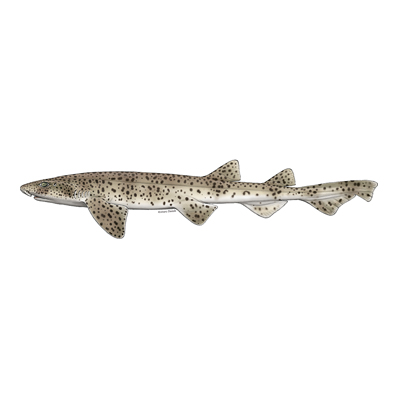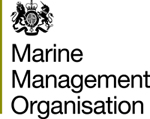

The largest species of cat shark in UK waters reaching 160cm in length. The nursehound or bull huss are the most commonly used names but its official name is the greater spotted catshark. Bull huss are closely related to the Lesser spotted dogfish. They are not generally targeted by Cornish fishermen although their meat is good to eat, as it is extremely hard and time consuming to remove their tough abrasive skin.
This species is rarely targeted but occasionally caught as bycatch by Cornish fishermen. Its distribution is patchy and little is known about the state of stocks of this slow growing and vulnerable species of shark. Nursehound is listed as Near Threatened by IUCN, the World Conservation Union. Latest information from ICES shows that populations are healthy and that fishing pressure is low. There is little demand for this species.
1.1 tonnes of bull huss were landed to Cornish ports in 2019 (MMO data).
Updated April 2024
Cornish boats landing to Cornish Ports
Gill nets are lightweight nets made of nylon (monofilament) fishing line that are anchored to the seabed and are used to catch fish by entangling the gills.
Learn moreCornish boats landing to Cornish ports
Potting is a selective and low impact method and within the 6 mile limits Cornwall Inshore Fisheries and Conservation authority monitor and strictly regulate the fishery. Crab Stocks are most healthy off Cornwall's South Coast.
Learn moreCornish boats landing to Cornish ports
Demersal trawls are large nets that are pulled through the water with the bottom edge of the net touching the seabed.
Learn moreCornwall Good Seafood Guide rates fish on sustainability using a scale of 1 to 5.
1, 2 and 3 are recommended, Fish to avoid are rated 5.
We use the system devised by the Marine Conservation Society (MCS) so our scores are comparable with the scores produced by MCS for the UK and fisheries from all around the world. For more information on scoring click here.
Scyliorhinus stellaris. Bull Huss or Nursehound are the largest cat shark species found in UK waters and are closely related to the Lesser spotted dogfish. They are a slow moving species that lives in rocky areas on and near the seabed and feeds on crustaceans fish and molluscs. They grow slowly and once mature produce a small number of large well developed eggs each year. Within each egg case one baby shark grows and when hatched they are 16cm in length. Egg laying occurs during spring and summer in shallow water. It is thought that the Fal Estuary in Cornwall is an extensive and important laying area and nursery ground for the species due to the large number of eggcases and animals found there (Orton, 1926) shallow coastal waters at Marazion and Hannafore point Looe are also important nursery areas for this species. Very high biological vulnerability rating 75 out of 100 ref Cheung et al 2005.
Although thought of as common in Cornwall the stock status of nursehound is generally unknown because of historical misidentification in landing data and its low, irregular appearances in scientific surveys. Latest ICES advice, which covers a large geographical area shows an improvement in stocks of Nursehound with a stock size indictor above MSY and fishing pressure below levels needed for MSY . There is no Total Allowable Catch for demersal elasmobranchs, such as nursehound. ICES advises that this species should be monitored appropriately and also recommends that catches should not increase. However, the current catch level is uncertain and genus specific landing information, which is currently lacking, is needed. Assessed as Near Threatened (2008) by IUCN, the World Conservation Union.
There is no specific management plan for demersal elasmobranchs, and no minimum landing size for Nursehound. Given the regional differences in skate assemblages and fisheries, ICES recommends that management measures for elasmobranchs be developed on a case-by-case basis. There are also prohibitions on fishing for, retaining and landing some species, including the most severely depleted species taken as by-catch in mixed demersal fisheries. ICES does not advise that general or species specific TACs be established at present because they are not the most effective means to regulate these by-catch species. TACs alone may not adequately protect these species as there are differences among species in their vulnerabilities to exploitation and a restrictive TAC may lead to discarding. Instead seasonal and/or area closures, effort restrictions and measures to protect spawning grounds for example are recommended.
Nursehound is generally taken as bycatch in longline and trawl fisheries and is often reported and landed under a mixed 'sharks' category, rather than by the species name. In Cornwall it is often caught in gill net fisheries, and occasionally they are caught in crab and lobster pots.






Cornwall Good Seafood Guide is underpinned by the Marine Conservation Society (MCS) Good Fish Guide. The first UK consumer guide to sustainable seafood. For more information visit www.fishonline.org
Cornwall Good Seafood Guide is here to help us all make sustainable seafood choices. Choices that will help us keep the oceans healthy and Cornish fishers' futures safe. This website is funded by Cornwall Wildlife Trust. If you would like to make a meaningful difference to the health of our oceans, please consider making a donation to the Cornwall Wildlife Trust Ocean Emergency fund. Your donation will help safeguard these remarkable environments, ensuring that they continue to thrive for generations to come. Together, we can be stewards of the seas and champions for a healthier, more sustainable future.